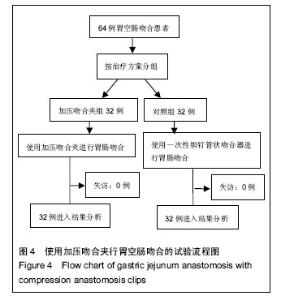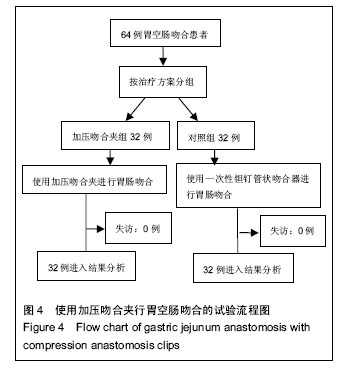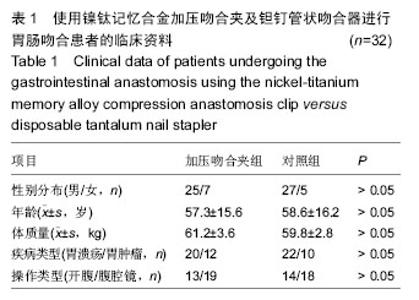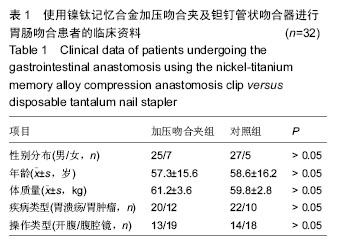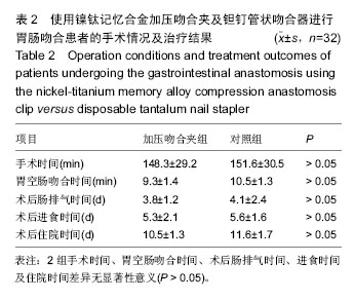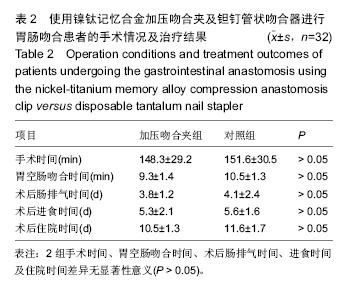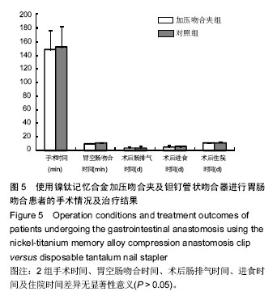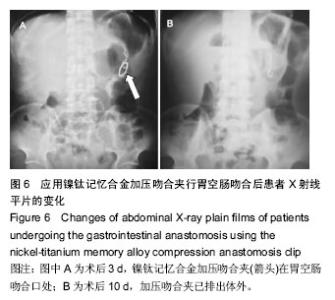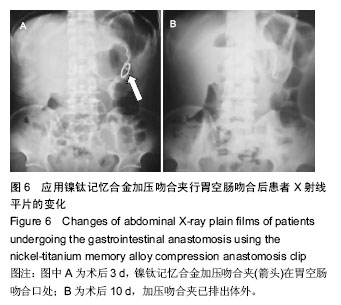Chinese Journal of Tissue Engineering Research ›› 2016, Vol. 20 ›› Issue (43): 6458-6464.doi: 10.3969/j.issn.2095-4344.2016.43.011
Previous Articles Next Articles
Safety and efficacy of nickel-titanium memory alloy compression anastomosis clip in gastroenterostomy
- Department of Gastrointestinal Surgery, Sichuan Academy of Medical Science & Sichuan Provincial People’s Hospital, Chengdu 610072, Sichuan Province, China
-
Received:2016-09-07Online:2016-10-21Published:2016-10-21 -
Contact:Yang Chun, Master, Associate chief physician, Department of Gastrointestinal Surgery, Sichuan Academy of Medical Science & Sichuan Provincial People’s Hospital, Chengdu 610072, Sichuan Province, China -
About author:Zheng Hang, Master, Attending physician, Department of Gastrointestinal Surgery, Sichuan Academy of Medical Science & Sichuan Provincial People’s Hospital, Chengdu 610072, Sichuan Province, China -
Supported by:the Project of Health Department of Sichuan Province, No. 2012JY0055
CLC Number:
Cite this article
Zheng Hang, Yang Chun, Guo Zhi-yi, Wang Kang, Zhang Wei, Hou Neng-yi.
share this article
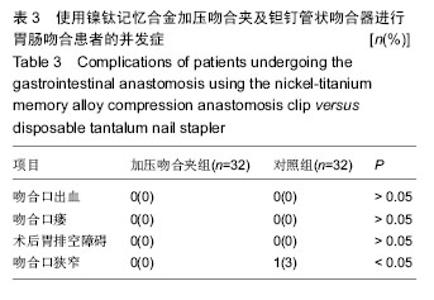
2.5 不良反应 2组均未发生术中吻合口出血、术后吻合口瘘及胃排空障碍等并发症。加压吻合夹组未发生吻合口狭窄;但对照组出现1例,发生率为3%,2组比较有显著差异(P < 0.05),见表3。 加压吻合夹组术后3 d腹部X射线平片检查显示镍钛记忆合金加压吻合夹均在原位,于术后9-28 d排出体外。 文章结果显示,加压吻合夹组中2例患者镍钛记忆合金加压吻合夹于术后28 d才排出,期间出现腹痛,但未出现肠梗阻、感染及吻合口狭窄等不良反应。 加压吻合夹组术后6个月复查胃镜,均显示胃肠吻合口光滑平整,无充血水肿等组织反应。而对照组出现1例吻合口狭窄,提示镍钛记忆合金加压吻合夹具有更加良好的组织相容性。"
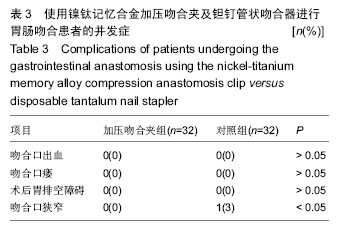
| [1]李心翔,叶建新,石铮,等.镍钛记忆合金加压吻合夹用于全胃切除术后消化道重建效果分析[J].中国实用外科杂志, 2008,28(7):559-560. [2]傅木海.镍钛记忆合金加压吻合夹227例胃肠吻合手术的应用体会[D].福州:福建医科大学,2012. [3]李良庆,傅木海,潘敦.镍钛记忆合金加压吻合夹在胃肠吻合中的应用[J].中华消化外科杂志,2013,12(7):504-507. [4]曾毅,陈夏,应敏刚.镍钛记忆合金加压吻合夹在腹腔镜结肠癌手术中的应用[J].中华胃肠外科杂志, 2007,10(6): 539. [5]吴宏梓,史平平,王建民.镍钛记忆合金压力吻合夹在消化道吻合术中疗效及安全性的Meta分析[J].中国循证医学杂志,2014,14(8):942-949. [6]Ku?nierz K, Lampe P. Long term results of the use of compression anastomosis clips (CAC) in gastrointestinal surgery – the first report. Pol Przegl Chir. 2015;87(6):295-300. [7]Lee HY, Woo JH, Park SY, et al. Intestinal Anastomosis by Use of a Memory-shaped Compression Anastomosis Clip (Hand CAC 30): Early Clinical Experience. J Korean Soc Coloproctol. 2012;28(2):83-88. [8]Ku?nierz K, Kajor M, Zaworonkow D, et al. Compression Anastomosis Clips Versus a Hand-Sewn Technique for Intestinal Anastomosis in Pigs. Adv Clin Exp Med. 2015;24(6):1019-1029. [9]Kusnierz K, Lekston Z, Zhavoronkov D, et al. A nickel-titanium memory-shape device for gastrojejunostomy: comparison of the compression anastomosis clip and a hand-sewn anastomosis. J Surg Res. 2014;187(1):94-100. [10]Li XX, Zheng CZ, Yin K, et al. Application of laparoscopic compression anastomosis clip for laparoscopic gastrointestinal anastomosis. Zhonghua Wei Chang Wai Ke Za Zhi. 2008;11(3):228-230. [11]Hua S, Xiong L, Wen Y, et al. Safety and efficacy of gastrointestinal anastomosis with nickel titanium compression anastomosis clip. Zhong Nan Da Xue Xue Bao Yi Xue Ban. 2011;36(4):351-354. [12]Zhang D, Zheng C, Song C. A modified method of using laparoscopic compression anastomosis clip for gastrointestinal anastomosis. Minim Invasive Ther Allied Technol. 2010;19(6):350-354. [13]Liu PC, Jiang ZW, Zhu XL, et al. Compression anastomosis clip for gastrointestinal anastomosis. World J Gastroenterol. 2008;14(31):4938-4942. [14]Liem RK, Niloff PH. Clinical experience using the computerized digital stapling system in open gastric bypass surgery for morbid obesity. Obes Surg. 2003; 13(6):837-841. [15]Tucker ON, Beglaibter N, Rosenthal RJ. Compression anastomosis for Roux-en-Y gastric bypass: observations in a large animal model. Surg Obes Relat Dis. 2008;4(2):115-121. [16]Li NN, Zhao WT, Wu XT. Can a nickel-titanium memory-shape device serve as a substitute for the stapler in gastrointestinal anastomosis? A systematic review and meta-analysis. J Surg Res. 2016;201(1): 82-93. [17]Kusnierz K, Morawiec H, Lekston Z, et al. NiTi shape memory compression anastomosis clip in small- and large-bowel anastomoses: first experience. Surg Innov. 2013;20(6):580-585. [18]Kim HR, Lee WY, Jung KU, et al. Early surgical outcomes of NiTi endoluminal compression anastomotic clip (NiTi CAC 30) use in patients with gastrointestinal malignancy. J Laparoendosc Adv Surg Tech A. 2012;22(5):472-478. [19]Koo EJ, Choi HJ, Woo JH, et al. Anastomosis by use of compression anastomosis ring (CAR™ 27) in laparoscopic surgery for left-sided colonic tumor. Int J Colorectal Dis. 2012;27(3):391-396. [20]Chun J, Lee D, Stewart D, et al. Comparison of the compression anastomosis ring (EndoCAR) with a circular stapled anastomosis in a porcine model. Surg Innov. 2011;18(3):235-240. [21]Stewart D, Hunt S, Pierce R, et al. Validation of the NITI Endoluminal Compression Anastomosis Ring (EndoCAR) device and comparison to the traditional circular stapled colorectal anastomosis in a porcine model. Surg Innov. 2007;14(4):252-260. [22]Tucker ON, Beglaibter N, Rosenthal RJ. Compression anastomosis for Roux-en-Y gastric bypass: observations in a large animal model. Surg Obes Relat Dis. 2008 r;4(2):115-121. [23]Song C, Frank T, Cuschieri A. Shape memory alloy clip for compression colonic anastomosis. J Biomech Eng. 2005;127(2):351-354. [24]Shalimov AA, Kopchak VM, Khomiak IB, et al. Application of the compression biliary-digestive anastomosis in surgical treatment of the biliary ducts obstruction. Klin Khir. 2000;(12):5-8. [25]Rebuffat C, Rosati R, Fumagalli U, et al. Experimental oesophagogastric anastomosis: preliminary report of a new compression device that also fragments. Br J Surg. 1996;83(11):1616-1619. [26]Nudelman IL, Fuko VV, Morgenstern S, et al. Gastrointestinal anastomosis with the nickel-titanium double ring. World J Surg. 2000;24(7):874-877. [27]李良庆,栗大伟,杨洋.镍钛记忆合金加压吻合夹行小肠吻合182例[J].广东医学,2014,35(3):390-392. [28]蔡绍环,徐志峰,杨永锐,等.镍钛记忆合金加压吻合夹在全胃切除术中的应用[J].医学综述,2013,19(2):379-380. [29]栗大伟.应用镍钛记忆合金加压吻合夹行小肠吻合的安全性与有效性分析[D].福州:福建医科大学,2012. [30]华颂文,熊力,文宇,等.应用镍钛记忆合金加压吻合夹行胃肠吻合的安全性与有效性分析[J].中南大学学报(医学版), 2011,36(4):351-354. [31]Tulchinsky H, Kashtan H, Rabau M, et al. Evaluation of the NiTi Shape Memory BioDynamix ColonRing™ in colorectal anastomosis: first in human multi-center study. Int J Colorectal Dis. 2010;25(12):1453-1458. [32]Detweiler MB, Kobos JW, Fenton J. Gastrointestinal sutureless anastomosis in pigs using absorbable intraluminal stents, stent placement devices, and fibrin glue - a summary. Langenbecks Arch Surg. 1999; 384(5):445-452. [33]Robak AN. Use of the shape memory effect of a titanium nickelide spring in a suturing device for the formation of compression esophageal anastomoses. Bull Exp Biol Med. 2008;146(5):620-623. [34]Jiang ZW, Li N, Li JS, et al. Small bowel anastomosis performed with the nickel-titanium temperature-dependent memory-shape device. Zhonghua Wei Chang Wai Ke Za Zhi. 2006;9(5): 392-394. [35]Detweiler MB, Verbo A, Kobos JW, et al. Gastrointestinal sutureless anastomosis using fibrin glue: reinforcement of the sliding absorbable intraluminal nontoxic stent and development of a stent placement device. J Invest Surg. 1996;9(2):111-130 |
| [1] | Chen Ziyang, Pu Rui, Deng Shuang, Yuan Lingyan. Regulatory effect of exosomes on exercise-mediated insulin resistance diseases [J]. Chinese Journal of Tissue Engineering Research, 2021, 25(25): 4089-4094. |
| [2] | Chen Yang, Huang Denggao, Gao Yuanhui, Wang Shunlan, Cao Hui, Zheng Linlin, He Haowei, Luo Siqin, Xiao Jingchuan, Zhang Yingai, Zhang Shufang. Low-intensity pulsed ultrasound promotes the proliferation and adhesion of human adipose-derived mesenchymal stem cells [J]. Chinese Journal of Tissue Engineering Research, 2021, 25(25): 3949-3955. |
| [3] | Yang Junhui, Luo Jinli, Yuan Xiaoping. Effects of human growth hormone on proliferation and osteogenic differentiation of human periodontal ligament stem cells [J]. Chinese Journal of Tissue Engineering Research, 2021, 25(25): 3956-3961. |
| [4] | Sun Jianwei, Yang Xinming, Zhang Ying. Effect of montelukast combined with bone marrow mesenchymal stem cell transplantation on spinal cord injury in rat models [J]. Chinese Journal of Tissue Engineering Research, 2021, 25(25): 3962-3969. |
| [5] | Gao Shan, Huang Dongjing, Hong Haiman, Jia Jingqiao, Meng Fei. Comparison on the curative effect of human placenta-derived mesenchymal stem cells and induced islet-like cells in gestational diabetes mellitus rats [J]. Chinese Journal of Tissue Engineering Research, 2021, 25(25): 3981-3987. |
| [6] | Hao Xiaona, Zhang Yingjie, Li Yuyun, Xu Tao. Bone marrow mesenchymal stem cells overexpressing prolyl oligopeptidase on the repair of liver fibrosis in rat models [J]. Chinese Journal of Tissue Engineering Research, 2021, 25(25): 3988-3993. |
| [7] | Liu Jianyou, Jia Zhongwei, Niu Jiawei, Cao Xinjie, Zhang Dong, Wei Jie. A new method for measuring the anteversion angle of the femoral neck by constructing the three-dimensional digital model of the femur [J]. Chinese Journal of Tissue Engineering Research, 2021, 25(24): 3779-3783. |
| [8] | Meng Lingjie, Qian Hui, Sheng Xiaolei, Lu Jianfeng, Huang Jianping, Qi Liangang, Liu Zongbao. Application of three-dimensional printing technology combined with bone cement in minimally invasive treatment of the collapsed Sanders III type of calcaneal fractures [J]. Chinese Journal of Tissue Engineering Research, 2021, 25(24): 3784-3789. |
| [9] | Qian Xuankun, Huang Hefei, Wu Chengcong, Liu Keting, Ou Hua, Zhang Jinpeng, Ren Jing, Wan Jianshan. Computer-assisted navigation combined with minimally invasive transforaminal lumbar interbody fusion for lumbar spondylolisthesis [J]. Chinese Journal of Tissue Engineering Research, 2021, 25(24): 3790-3795. |
| [10] | Hu Jing, Xiang Yang, Ye Chuan, Han Ziji. Three-dimensional printing assisted screw placement and freehand pedicle screw fixation in the treatment of thoracolumbar fractures: 1-year follow-up [J]. Chinese Journal of Tissue Engineering Research, 2021, 25(24): 3804-3809. |
| [11] | Shu Qihang, Liao Yijia, Xue Jingbo, Yan Yiguo, Wang Cheng. Three-dimensional finite element analysis of a new three-dimensional printed porous fusion cage for cervical vertebra [J]. Chinese Journal of Tissue Engineering Research, 2021, 25(24): 3810-3815. |
| [12] | Wang Yihan, Li Yang, Zhang Ling, Zhang Rui, Xu Ruida, Han Xiaofeng, Cheng Guangqi, Wang Weil. Application of three-dimensional visualization technology for digital orthopedics in the reduction and fixation of intertrochanteric fracture [J]. Chinese Journal of Tissue Engineering Research, 2021, 25(24): 3816-3820. |
| [13] | Sun Maji, Wang Qiuan, Zhang Xingchen, Guo Chong, Yuan Feng, Guo Kaijin. Development and biomechanical analysis of a new anterior cervical pedicle screw fixation system [J]. Chinese Journal of Tissue Engineering Research, 2021, 25(24): 3821-3825. |
| [14] | Lin Wang, Wang Yingying, Guo Weizhong, Yuan Cuihua, Xu Shenggui, Zhang Shenshen, Lin Chengshou. Adopting expanded lateral approach to enhance the mechanical stability and knee function for treating posterolateral column fracture of tibial plateau [J]. Chinese Journal of Tissue Engineering Research, 2021, 25(24): 3826-3827. |
| [15] | Zhu Yun, Chen Yu, Qiu Hao, Liu Dun, Jin Guorong, Chen Shimou, Weng Zheng. Finite element analysis for treatment of osteoporotic femoral fracture with far cortical locking screw [J]. Chinese Journal of Tissue Engineering Research, 2021, 25(24): 3832-3837. |
| Viewed | ||||||
|
Full text |
|
|||||
|
Abstract |
|
|||||
